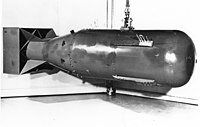
Photo from wikipedia
The simplest configuration of mitochondria in a cell is as small separate organellar units. Instead, mitochondria often form a dynamic, intricately connected network. A basic understanding of the topological properties… Click to show full abstract
The simplest configuration of mitochondria in a cell is as small separate organellar units. Instead, mitochondria often form a dynamic, intricately connected network. A basic understanding of the topological properties of mitochondrial networks, and their influence on cell function is lacking. We performed an extensive quantitative analysis of mitochondrial network topology, extracting mitochondrial networks in 3D from live-cell microscopic images of budding yeast cells. In the presence of fission and fusion, mitochondrial network structures exhibited certain topological properties similar to other real-world spatial networks. Fission and fusion dynamics were required to efficiently distribute mitochondria throughout the cell and generate highly interconnected networks that can facilitate efficient diffusive search processes. Thus, mitochondrial fission and fusion combine to regulate the underlying topology of mitochondrial networks, which may independently impact cell function.
Journal Title: Cell systems
Year Published: 2020
Link to full text (if available)
Share on Social Media: Sign Up to like & get
recommendations!